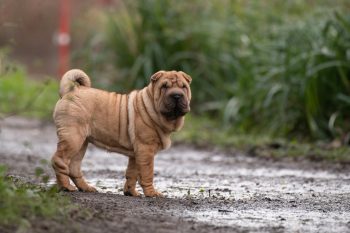The Shar Pei, with its distinctive deep wrinkles and blue-black tongue, is a breed that hails from ancient China, boasting a rich history that dates back over two thousand years. Originally bred for hunting, herding, and guarding, this unique dog has played various roles throughout its history. The name “Shar Pei” translates to “sand skin” in Cantonese, referring to the rough texture of its coat. This breed nearly faced extinction in the 20th century, but thanks to the efforts of dedicated breeders and enthusiasts, the Shar Pei was revived and has since gained popularity worldwide. Known for its loyalty and independent nature, the Shar Pei is a breed that combines the qualities of a companion dog with those of a guardian. This article aims to explore the fascinating history and origin of the Shar Pei, shedding light on its development, characteristics, and the journey it has undergone from ancient farms in China to modern homes around the globe.
The Ancient Origins of the Shar Pei
The Shar Pei is believed to have originated in the southern provinces of China, particularly around the area of Guangdong. Historical records and artifacts, including statues and tomb carvings, suggest that dogs resembling the Shar Pei were present during the Han Dynasty (206 BC – 220 AD). These early dogs were valued for their versatility, serving as hunters, farm animals’ herders, and property guardians. The Shar Pei’s loose, wrinkled skin was thought to protect it from the bites of animals and opponents, while its rough coat could deter bites and grabs. Despite the lack of comprehensive historical documentation, these early depictions indicate that the Shar Pei has been a distinct breed for centuries, deeply rooted in Chinese culture.
Development and Roles Throughout History
Over the centuries, the Shar Pei’s role in Chinese society evolved. During the height of its existence in ancient times, the breed was likely involved in various activities, from hunting and guarding to being a valued companion. However, the Shar Pei’s fortunes waxed and waned with China’s political and social upheavals, leading to periods where the breed’s numbers and purity were at risk. In the mid-20th century, following the establishment of the People’s Republic of China, the Shar Pei, along with many other aspects of traditional Chinese life, faced severe decline due to the government’s policies against dog ownership. By the 1970s, the Shar Pei was considered one of the world’s rarest dog breeds.
The Shar Pei in the Modern World
The revival of the Shar Pei began in the 1970s when a Hong Kong businessman named Matgo Law appealed to Western dog lovers to assist in saving the breed from extinction. Photos of the Shar Pei were published in American dog magazines, sparking interest among U.S. breeders and dog enthusiasts. This led to the importation of Shar Pei specimens to the United States, where dedicated breeding programs helped to increase the breed’s numbers and genetic diversity. The American Kennel Club (AKC) officially recognized the Shar Pei in 1992. Today, the Shar Pei is cherished not only for its unique appearance but also for its loyal and somewhat aloof character, serving as a devoted family pet and guardian.
Characteristics and Temperament of the Shar Pei
The Shar Pei is known for its distinctive appearance, characterized by deep wrinkles that cover its head, body, and particularly around the face and neck. The breed has a broad, flat head with a blue-black tongue, another unique feature it shares with the Chow Chow, hinting at a possible common ancestry. Shar Peis have a short, bristly coat that comes in various colors. They are medium-sized dogs, known for their strength, square profile, and alert expression. Temperament-wise, Shar Peis are independent, loyal, and reserved with strangers, making them excellent watchdogs. They are affectionate with their families but can be stubborn, requiring early socialization and consistent training.
The Shar Pei’s journey from ancient Chinese farms to modern homes worldwide is a testament to the breed’s resilience and the dedication of those who worked to save it from extinction. With its unique appearance and strong, loyal temperament, the Shar Pei continues to be a beloved companion and guardian. While it may no longer herd or hunt as its ancestors did, the Shar Pei remains a symbol of cultural heritage and a living link to ancient China. As the breed moves forward, it carries with it the legacy of its rich history, embodying the spirit and strength that have characterized the Shar Pei for centuries.
Frequently Asked Questions About The History of Shar Peis
The post The History and Origin of the Shar Pei: A Comprehensive Look appeared first on iHeartDogs.com.

